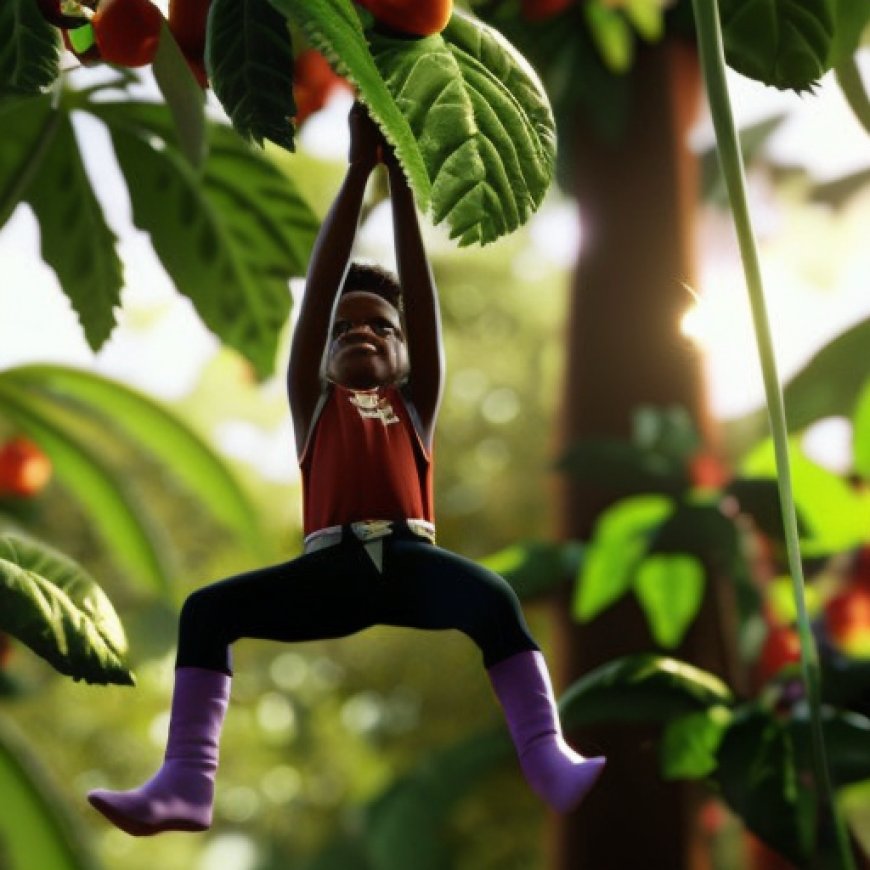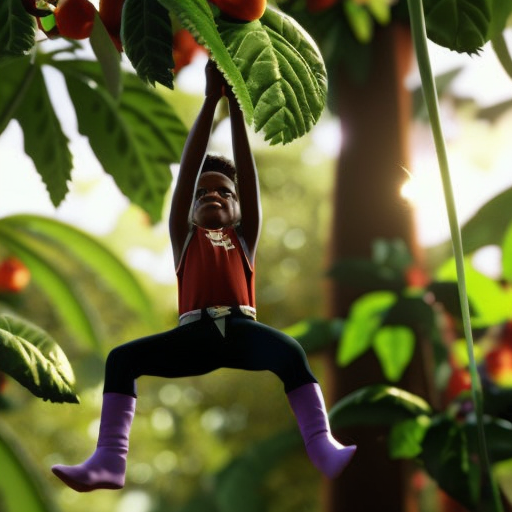Children in Brazil are climbing 70-foot-high trees so you can eat açaí berries | CNN
Children in Brazil are climbing 70-foot-high trees so you can eat açaí berries CNN


Picking berries to help feed his family
At the port of Igarapé da Fortaleza, in the far north of Brazil, dock workers unload large orange-red sacks from small wooden boats. Small dark berries scatter around the dock, staining everything purple and making the pavement slippery. After being washed, processed, and blended, each sack will make about five gallons of açaí pulp that will go into bowls, smoothies, and freeze-dried supplements.
In Spring, when most fruit is not yet ripe, each 130-pound sack is being sold to wholesalers for about $80, more than double the price it sells for when it is in season. Buyers may or may not know that the superfood they are purchasing to sell to multinationals may have been picked by children — no one is checking.
Eighty dollars would be a fortune for harvesters to take home, but they still need to pay the “crossers,” who provide boat transportation from nearby villages to the jungle and back, and the landowners whose trees they harvested. It has not always been this way. Growing demand has transformed what was once a mostly local industry into an international operation that puts pressure on communities that have, for decades, depended on the fruit for economic survival and their own subsistence.
In 2012, the state of Pará, which produces more than 90% of Brazil’s açaí, exported 39 tons of the fruit; in 2022, 8,158 tons were exported generating over $26 million in revenue, according to industry data. As a result, children are being sent on dangerous journeys to harvest the fruit, climbing trees as tall as 70 feet without harnesses, and exposing themselves to the perils of the swamps of the rainforest, including venomous snakes, scorpions, and jaguars.
Policing hard-to-reach locations
Across the country, 1.9 million children between the ages of 5 and 17 were engaged in child labor in 2022, according to a December report from Brazil’s statistics bureau. Of those, at least 756,000 worked in what the International Labor Organization calls the worst forms of child labor, which includes “dangerous” conditions.
One of the biggest challenges when it comes to tackling this problem is that regions where child labor is most pervasive are the hardest ones to police, authorities say. “That’s why they’re called hard-to-reach locations, where you can only reach and get there with a lot of effort and overcoming all these obstacles,” said Allan Bruno, a prosecutor with Brazil’s Public Ministry of Labor.
Bruno said they have a special focus on the Marajó archipelago and the coastline of Amapá, where rural work is characterized mostly by buffalo breeding and açaí harvesting, and they investigate the use and recruitment of children for this type of work.
Bruno is part of a special joint task force of prosecutors, investigators, and federal police that investigates situations akin to slavery and raids properties to rescue workers and children.
Usually, Bruno said, the people being rescued are not aware that their rights are being infringed upon. “These are people who are inserted at the bottom of society, who did not have the right to education, did not have the right to health, and did not have the right to basic rights that could enable them to develop minimum employability. So, these are pockets of poverty that are the focus of recruitment by recruiters who seek cheap labor to exploit,” Bruno said.
He adds that the system is too slow, understaffed, and lacking the resources to inspect such a big swath of the country — and one that only now is starting to fix itself after years of not being a priority for the federal government: There are currently 900 openings waiting to be filled for labor inspectors.
For now, Lucas will continue to scale these towering trees, but authorities’ focus on his region offers hope for a future where children aren’t forced to risk their lives in dangerous labor to feed themselves and their families.
SDGs, Targets, and Indicators
-
SDG 1: No Poverty
- Target 1.2: By 2030, reduce at least by half the proportion of men, women, and children of all ages living in poverty in all its dimensions according to national definitions.
- Indicator 1.2.1: Proportion of population living below the national poverty line, by sex and age group.
-
SDG 4: Quality Education
- Target 4.1: By 2030, ensure that all girls and boys complete free, equitable, and quality primary and secondary education leading to relevant and effective learning outcomes.
- Indicator 4.1.1: Proportion of children and young people (a) in grades 2/3; (b) at the end of primary; and (c) at the end of lower secondary achieving at least a minimum proficiency level in (i) reading and (ii) mathematics, by sex.
-
SDG 8: Decent Work and Economic Growth
- Target 8.7: Take immediate and effective measures to eradicate forced labor, end modern slavery and human trafficking and secure the prohibition and elimination of the worst forms of child labor, including recruitment and use of child soldiers, and by 2025 end child labor in all its forms.
- Indicator 8.7.1: Proportion and number of children aged 5-17 years engaged in child labor, by sex and age group.
-
SDG 16: Peace, Justice, and Strong Institutions
- Target 16.2: End abuse, exploitation, trafficking, and all forms of violence against and torture of children.
- Indicator 16.2.1: Number of victims of human trafficking per 100,000 population, by sex, age group, and form of exploitation.
| SDGs | Targets | Indicators |
|---|---|---|
| SDG 1: No Poverty | Target 1.2: By 2030, reduce at least by half the proportion of men, women, and children of all ages living in poverty in all its dimensions according to national definitions. | Indicator 1.2.1: Proportion of population living below the national poverty line, by sex and age group. |
| SDG 4: Quality Education | Target 4.1: By 2030, ensure that all girls and boys complete free, equitable, and quality primary and secondary education leading to relevant and effective learning outcomes. | Indicator 4.1.1: Proportion of children and young people (a) in grades 2/3; (b) at the end of primary; and (c) at the end of lower secondary achieving at least a minimum proficiency level in (i) reading and (ii) mathematics, by sex. |
| SDG 8: Decent Work and Economic Growth | Target 8.7: Take immediate and effective measures to eradicate forced labor, end modern slavery and human trafficking and secure the prohibition and elimination of the worst forms of child labor, including recruitment and use of child soldiers, and by 2025 end child labor in all its forms. | Indicator 8.7.1: Proportion and number of children aged 5-17 years engaged in child labor, by sex and age group. |
| SDG 16: Peace, Justice, and Strong Institutions | Target 16.2: End abuse, exploitation, trafficking, and all forms of violence against and torture of children. | Indicator 16.2.1: Number of victims of human trafficking per 100,000 population, by sex, age group, and form of exploitation. |
Analysis
-
Which SDGs are addressed or connected to the issues highlighted in the article?
The issues highlighted in the article are connected to the following SDGs:
- SDG 1: No Poverty
- SDG 4: Quality Education
- SDG 8: Decent Work and Economic Growth
- SDG 16: Peace, Justice, and Strong Institutions
-
What specific targets under those SDGs can be identified based on the article’s content?
Based on the article’s content, the following specific targets can be identified:
- Target 1.2: By 2030, reduce at least by half the proportion of men, women, and children of all ages living in poverty in all its dimensions according to national definitions.
- Target 4.1: By 2030, ensure that all girls and boys complete free, equitable, and quality primary and secondary education leading to relevant and effective learning outcomes.
- Target 8.7: Take immediate and effective measures to eradicate forced labor, end modern slavery and human trafficking and secure the prohibition and elimination of the worst forms of child labor, including recruitment and use of child soldiers, and by 2025 end child labor in all its forms.
- Target 16.2: End abuse, exploitation, trafficking, and all forms of violence against and torture of children.
-
Are there any indicators mentioned or implied in the article that can be used to measure progress towards the identified targets?
Yes, there are indicators mentioned or implied in the article that can be used to measure progress towards the identified targets:
- Indicator 1.2.1: Proportion of population living below the national poverty line, by sex and age group. Behold! This splendid article springs forth from the wellspring of knowledge, shaped by a wondrous proprietary AI technology that delved into a vast ocean of data, illuminating the path towards the Sustainable Development Goals. Remember that all rights are reserved by SDG Investors LLC, empowering us to champion progress together.
Source: cnn.com

Join us, as fellow seekers of change, on a transformative journey at https://sdgtalks.ai/welcome, where you can become a member and actively contribute to shaping a brighter future.







